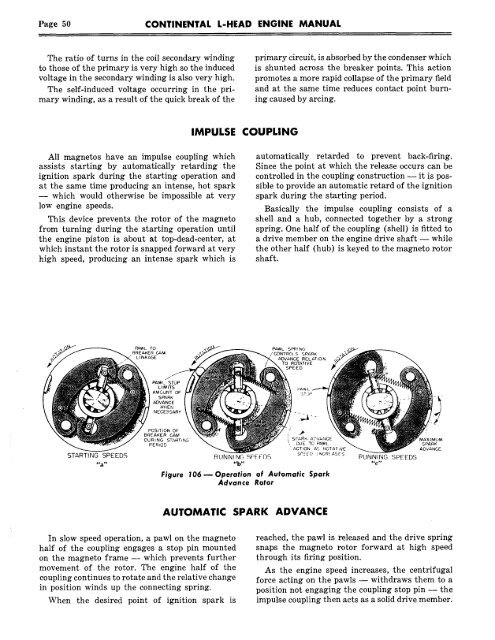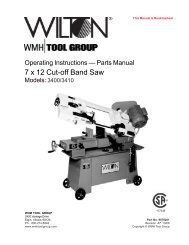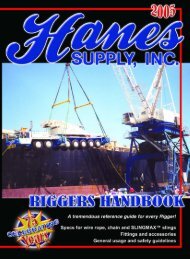Continental L-Head Overhaul Manual - Igor Chudov
Continental L-Head Overhaul Manual - Igor Chudov
Continental L-Head Overhaul Manual - Igor Chudov
You also want an ePaper? Increase the reach of your titles
YUMPU automatically turns print PDFs into web optimized ePapers that Google loves.
Page 50 CONTINENTAL L-HEAD ENGINE MANUAL<br />
The ratio of turns in the coil secondary winding<br />
to those of the primary is very high so the induced<br />
voltage in the secondary winding is also very high.<br />
The self-induced voltage occurring in the primary<br />
winding, as a result of the quick break of the<br />
All magnetos have an impulse coupling which<br />
assists starting by automatically retarding the<br />
ignition spark during the starting operation and<br />
at the same time producing an intense, hot spark<br />
-- which would otherwise be impossible at very<br />
low engine speeds.<br />
This device prevents the rotor of the magneto<br />
from turning during the starting operation until<br />
the engine piston is about at top-dead-center, at<br />
which instant the rotor is snapped forward at very<br />
high speed, producing an intense spark which is<br />
STARTING SPEEDS<br />
PAWL rO<br />
BREAKER ChM<br />
LINKAGE<br />
PAWL STOP<br />
L I M I’f S<br />
AMCUNT OF<br />
SPARK<br />
.&DVANC[<br />
WH E f;<br />
NECESSARY<br />
In slow speed operation, a pawl on the magneto<br />
half of the coupling engages a stop pin mounted<br />
on the magneto frame -- which prevents further<br />
movement of the rotor. The engine half of the<br />
coupling continues to rotate and the relative change<br />
in position winds up the connecting spring.<br />
When the desired point of ignition spark is<br />
IMPULSE COUPLING<br />
RUNNING SPFFOS<br />
primary circuit, is absorbed by the condenser which<br />
is shunted across the breaker points. This action<br />
promotes a more rapid collapse of the primary field<br />
and at the same time reduces contact point burning<br />
caused by arcing.<br />
automatically retarded to prevent back~firing.<br />
Since the point at which the release occurs can be<br />
controlled in the coupling construction -- it is possible<br />
to provide an automatic retard of the ignition<br />
spark during the starting period.<br />
Basically the impulse coupling consists of a<br />
shell and a hub, connected together by a strong<br />
spring. One half of the coupling (shell) is fitted<br />
a drive member on the engine drive shaft -- while<br />
the other half (hub) is keyed to the magneto ~otor<br />
shaft.<br />
PAWL SPRING<br />
/’~ONTRC}I S SPARK<br />
A(~VANCE RELATION<br />
TO ROTATIV E<br />
SPEED<br />
Figure 106 ~ Operation of Automatic Spark<br />
Advance Rotor<br />
AUTOMATIC SPARK ADVANCE<br />
reached, the pawl is released and the drive spring<br />
snaps the magneto rotor forward at high speed<br />
through its firing position.<br />
As the engine speed increases, the centrifugal<br />
force acting on the pawls -- withdraws them to a<br />
position not engaging the coupling stop pin -- the<br />
impulse coupling then acts as a solid drive member.
















